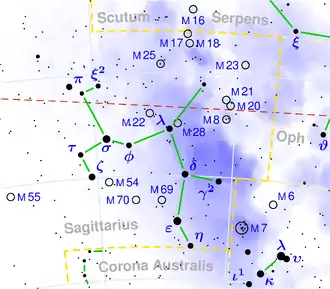Ny2 Sagittarii
Ny2 Sagittarii (ν2 Sagittarii) ist ein Doppelsternsystem[7] im Ekliptik-Sternbild Schütze, lateinisch Sagittarius. Er ist mit einer scheinbaren Helligkeit von +4.98 mag mit bloßem Auge kaum sichtbar.[2] Bei einer jährlichen Parallaxe von 11,91 Millibogensekunden[1] ist das System zirka 270 Lichtjahre von uns entfernt. Ny2 Sagittarii hat eine hohe Pekuliargeschwindigkeit von 86,0 (−14,4, +11,6) km/s und ist sehr wahrscheinlich ein sogenannter Schnellläufer.[3]
| Stern ν2 Sagittarii (Hauptkomponente) | |||||||||||||||
|---|---|---|---|---|---|---|---|---|---|---|---|---|---|---|---|
| |||||||||||||||
| ν2 Sagittarii im Sternbild Schütze | |||||||||||||||
| AladinLite | |||||||||||||||
| Beobachtungsdaten Äquinoktium: J2000.0, Epoche: J2000.0 | |||||||||||||||
| Sternbild | Schütze | ||||||||||||||
| Rektaszension | +18h 55m 7,14s [1] | ||||||||||||||
| Deklination | −2240° 16.8185′ [1] | ||||||||||||||
| Helligkeiten | |||||||||||||||
| Scheinbare Helligkeit | +4,98 mag [2] | ||||||||||||||
| Spektrum und Indices | |||||||||||||||
| B−V-Farbindex | +1,32 [2] | ||||||||||||||
| Spektralklasse | Ib–II [3] | ||||||||||||||
| Astrometrie | |||||||||||||||
| Radialgeschwindigkeit | −109,6 km/s [2] | ||||||||||||||
| Parallaxe | 11,91 ± 0,52 mas [1] | ||||||||||||||
| Entfernung | 270 ± 10 Lj 84 ± 4 pc | ||||||||||||||
| Visuelle Absolute Helligkeit Mvis | +0,38 mag [4] | ||||||||||||||
| Eigenbewegung [1] | |||||||||||||||
| Rek.-Anteil: | −109,04 mas/a | ||||||||||||||
| Dekl.-Anteil: | −35,25 mas/a | ||||||||||||||
| Physikalische Eigenschaften | |||||||||||||||
| Masse | 1,44 M☉ [2] | ||||||||||||||
| Radius | 85 R☉ [5] | ||||||||||||||
| Leuchtkraft | |||||||||||||||
| Effektive Temperatur | 4244 ± 57 K [2] | ||||||||||||||
| Metallizität [Fe/H] | −0,13 [6] | ||||||||||||||
| Alter | 4,52 Mrd a [2] | ||||||||||||||
| Andere Bezeichnungen und Katalogeinträge | |||||||||||||||
| |||||||||||||||
Das Spektrum der Hauptkomponente zeigt einen Spektraltyp K1 Ib–II[3], der auf einen entwickelten hellen Riesen oder Überriesen hinweist. Es handelt sich um einen schwachen Barium-Stern, der in seiner äußeren Atmosphäre einen erhöhten Überschuss an s-Prozess-Elementen zeigt. Dieses Material stammt höchstwahrscheinlich aus einem früheren Massetransfer des Begleiters, der nun ein weißer Zwerg ist.[8] Die Hauptkomponente hat geschätzt das 1,4fache[2] der Sonnenmasse und eine Ausdehnung vom 85fachen[5] des Sonnenradius.
Siehe auch
Einzelnachweise
- F. van Leeuwen: Validation of the new Hipparcos reduction, Astronomy and Astrophysics, 2007, Band 474, Ausgabe 2, Seiten 653–664, arXiv 0708.1752
- R. Earle Luck: Abundances in the Local Region. I. G and K Giants, Astronomical Journal (2015), Band 150 Ausgabe 3, Seite 88, arXiv 1507.01466
- N. Tetzlaff, R. Neuhäuser, M. M. Hohle: A catalogue of young runaway Hipparcos stars within 3 kpc from the Sun, Monthly Notices of the Royal Astronomical Society, Januar 2011, Band 410, Ausgabe 1, Seiten 190–200, arXiv 1007.4883
- E. Anderson, Ch. Francis, XHIP: An extended hipparcos compilation, Astronomy Letters (2012), Band 38, Ausgabe 5, Seite 331, arXiv 1108.4971
- L. E. Pasinetti Fracassini, L. Pastori, S. Covino, A. Pozzi; Catalogue of Apparent Diameters and Absolute Radii of Stars (CADARS), Astronomy and Astrophysics (2001), Band 376, Seiten 521–524, arXiv astro-ph/0012289
- C. Soubiran, J.-F. Le Campion, G. Cayrel de Strobel, A. Caillo; The PASTEL catalogue of stellar parameters, Astronomy and Astrophysics, Juni 2010, Band 515, Seite A111, arXiv 1004.1069
- P. P. Eggleton, A. A. Tokovinin: A catalogue of multiplicity among bright stellar systems, Monthly Notices of the Royal Astronomical Society, September 2008, Band 389, Ausgabe 2, Seiten 869–879, arXiv 0806.2878
- A. E. Gomez, X. Luri, S. Grenier, L. Prevot, M. O. Mennessier, F, Figueras, J. Torra: Absolute magnitudes and kinematics of barium stars, Astronomy and Astrophysics (1997), Band 319, Seite 881, Bibcode 1997A&A...319..881G
